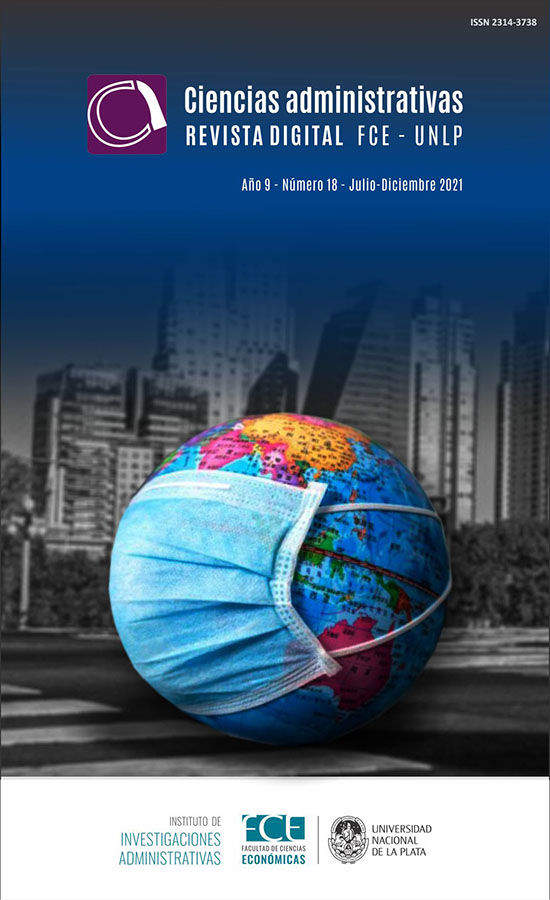Extended Product Life Cycle Model: PLC Approach From the perspective of Large Technological Systems
DOI:
https://doi.org/10.24215/23143738e084Keywords:
complex systems, social technology studies, research-to-market trajectoryAbstract
The Expanded Life Cycle Product (Expanded LCP) model is a proposal developed from the confluence of two pre-existing visions: on the one hand, the conception of large technological systems, developed by Thomas Hughes in 1987 and, on the other hand, the life cycle product model (LCP). The Expanded LCP model aims to promote the understanding of the phases that follow from the invention process of a basic principle, the generation of the innovative product, its introduction to the market, its maturity and its decline. Each phase proposes challenges from a technological and business point of view and portrays the arrival of certain actors that make up a complex and varied social network.
The essay begins by analysing the construction of large technological systems, a perspective typical of social technology studies, which concentrates its attention on the characterisation of the phases that large technological systems go through, understood as sociotechnical constructs. The following is a tour of the main features of the product life cycle model, a prescriptive model developed in the late 1960s and used for evaluating the product portfolio. Finding points of contact between both visions, the Extended LCP model proposes an analysis tool that integrates the two representations. This perspective will favour the understanding of the trajectory from research laboratories to market insertion, the visibility of the possible tensions as a result of the convergence of multiple actors with divergent positions and interests, and the appreciation of the focus on the decision making in the context of each phase or stage. The proposal may originate subsequent specific studies and research, linked to identifying particular trajectories at the product level, technical system or social group, to the generation of specific learning processes at the organisational level.
Downloads
Metrics
References
Aguilar, S., Avalos, A. F., Giraldo, D. P. y Zartha, J. W. (2012). La Curva en S como Herramienta para la Medición de los Ciclos de Vida de Productos. Journal of Technology, Management & Innovation, 7(1), 238-248.
Ansoff, H. I., Kipley, D., Lewis, A. y Roxane Helm-Stevens, R. A. (1984). Implanting Strategic Management. Prentice Hall.
Augustine, M., Yadav, O. P., Jain, R. y Rathore, A. P. (2010). Concept convergence process: A framework for improving products concepts. Computers & Industrial Engineering, 59(4), 367-377.
Best, R. J. (2007). Marketing Estratégico. Pearson Education.
Bijker, W., Thomas, H. y Trevor, P. (1987). The social constrution of technical systems: new directions in the sociology and history of tecnology. MIT Press.
Castro Gomez, S. y Grosfoguel, R. (2007). El giro decolonial: reflexiones para una diversidad epistémica más allá del capitalismo global. Siglo del Hombre Editores.
Hughes, T. (1996). El impulso tecnológico. En L. Marx y M. Roe Smith (Eds.), Historia y determinismo tecnológico (pp. 117-130). Alianza.
Hughes, T. (2008). La evolución de los grandes sistemas tecnológicos. En H. Thomas y A. Buch (Coords.), Actos, actores y artefactos: sociología de la Tecnología (pp. 101-146). Universidad Nacional de Quilmes. (Trabajo original publicado en 1987).
Kotler, P. (1993). Dirección de la mercadotecnia. Análisis, planeación, implementación y control. Prentice Hall.
Latour, B. (2001). La esperanza de Pandora. Ensayos sobre la realidad de los estudios de la ciencia. Gedisa.
Latour, B. (2008). Reensamblar lo social. Una introducción a la teoría del actor red. Manantial.
Lepratte, L. (2014). Complejidad, análisis sociotécnico y desarrollo: hacia programas de investigación convergentes entre los estudios sociales de la tecnología y la economía de la innovación y el cambio tecnológico. Redes, 20(38), 41-95.
Makki, L., Cadiat, A.-C. y Probert, C. (2015). Product lifecycle: the fundamental stages of every product. 50Minutos.
Mankins, J. C. (1995). Tecnology Readiness Levels: a white paper. Advanced Concepts Office; Office of Space Accesss and Technology NASA.
Matus, C. (2007). Los tres cinturones del gobierno (1ª ed.). Universidad Nacional de La Matanza.
Qureshi, A. J., Gericke, K. y Blessing, L. (2014). Stages in product lifecicle: Trans-disciplinary design context. Procedia CIRP, 21, 224-229. https://doi.org/10.1016/j.procir.2014.03.131
Ries, E. (2011). The Lean Startup: How today´s entrepreneurs use continuos innovacion to create radically successful businesses. Crown Publishing.
Rogers, E. M. (1995). Diffusion of Innovations (4ª ed.). The Free Press.
Wheelen, T. y Hunger, J. D. (2007). Administración estratégica y política de negocios.Pearson Educación.
Downloads
Additional Files
Published
How to Cite
Issue
Section
License
Those authors who have publications with this journal, agree with the following terms:
a. Authors will retain its copyright and will ensure the rights of first publication of its work to the journal, which will be at the same time subject to the Creative Commons Atribución-NoComercial-CompartirIgual 4.0 Internacional (CC BY-NC-SA 4.0) allowing third parties to share the work as long as the author and the first publication on this journal is indicated.
b. Authors may elect other non-exclusive license agreements of the distribution of the published work (for example: locate it on an institutional telematics file or publish it on an monographic volume) as long as the first publication on this journal is indicated,
c. Authors are allowed and suggested to disseminate its work through the internet (for example: in institutional telematics files or in their website) before and during the submission process, which could produce interesting exchanges and increase the references of the published work. (see The effect of open Access)





































